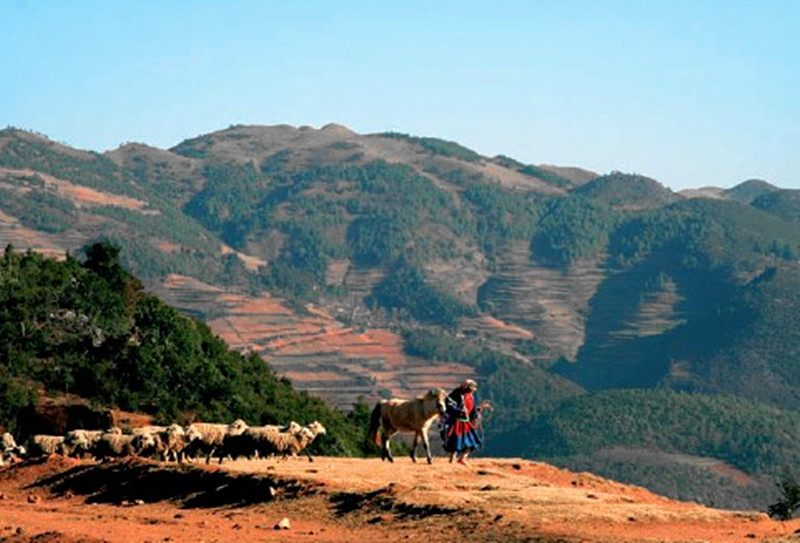 alt="Puer Surrounding Counties and Towns: Weekly & Special Local Markets Travel Guide"
/>
alt="Puer Surrounding Counties and Towns: Weekly & Special Local Markets Travel Guide"
/>
“Zhaobangjian & Gaopanshi” – Narrative Poem of Miao Ethnic Minority
Introduction
The Miao ethnic minority narrative poem Zhaobangjian & Gaopanshi (苗族叙事长诗《昭蒡俭和高帕施》) is widely circulated in the Miao regions of Kunming, Qujing, Zhaotong, and Chuxiong. This narrative poem tells the story of a young Miao couple, Zhaobangjian (昭蒡俭) and Gaopanshi (高帕施), who, in their pursuit of a beautiful and free love, use clever tactics to escape from the clutches of the evil man Duomanduolong (多漫多龙), who wants to forcibly marry Gaopanshi. They face numerous trials and dangers, managing to escape from Duomanduolong’s pursuit, eventually reaching a place called “Tianbian” (天边), a land far away from the tyranny of black forces, leading them toward a better life.
Seven years later, the celestial being Yayang (仙人亚盎) learns of the couple’s escape to Tianbian for freedom and happiness. Yayang sends divine soldiers to help the couple eliminate the wicked Duomanduolong, allowing Zhaobangjian and Gaopanshi to return home and reunite with their family.
Themes and Symbolism
Zhaobangjian & Gaopanshi carries a strong anti-feudal message, with Duomanduolong representing the embodiment of feudal ruling classes. Through the courageous struggle of Zhaobangjian and Gaopanshi against the forced marriage imposed by Duomanduolong, the poem reflects the Miao people’s spirit of resisting and overcoming oppression by feudal rulers. The poem has had a lasting and positive influence in the Miao community. Whenever someone is hesitant in the face of difficulties, they are reminded of Zhaobangjian and Gaopanshi’s escape to Tianbian, saying, “If they can escape from Duomanduolong’s pursuit and find a better life, what is your difficulty?”
Young people view Zhaobangjian and Gaopanshi as role models in their struggle against evil forces and marriage oppression, while middle-aged and older generations regard them as symbols of resistance against feudal rulers.
Cultural and Historical Significance
After the founding of the People’s Republic of China, Miao singer Lu Xingfeng (陆兴凤) from Xundian Hui and Yi Autonomous County in Kunming collected and compiled the poem. She translated it into Chinese, and the full poem, consisting of 1,160 lines, was divided into 10 sections. It was published in Folk Literature (《民间文学》), a journal of the China Federation of Literary and Art Circles and the China Folklore Research Association (1964, Issue 3, No. 96, People’s Literature Publishing House). The publication attracted attention from both Miao communities and academic circles.
The poem’s language is rich in ethnic and local characteristics, with vivid depictions of the characters, environment, and atmosphere. It has been passed down orally in Miao language among the Miao people. However, today, there are fewer and fewer singers who can perform the entire poem in its original Miao language.
For more details, visit: http://www.ynich.cn/view-ml-11111-1108.html

 7 Days GolfingTour
7 Days GolfingTour
 8 Days Group Tour
8 Days Group Tour
 8 Days Yunnan Tour
8 Days Yunnan Tour
 7 Days Shangri La Hiking
7 Days Shangri La Hiking
 11 Days Yunnan Tour
11 Days Yunnan Tour
 6 Days Yuanyang Terraces
6 Days Yuanyang Terraces
 11 Days Yunnan Tour
11 Days Yunnan Tour
 8 Days South Yunnan
8 Days South Yunnan
 7 Days Tea Tour
7 Days Tea Tour
 8 Days Muslim Tour
8 Days Muslim Tour
 12 Days Self-Driving
12 Days Self-Driving
 4 Days Haba Climbing
4 Days Haba Climbing
 Tiger Leaping Gorge
Tiger Leaping Gorge
 Stone Forest
Stone Forest
 Yunnan-Tibet
Yunnan-Tibet
 Hani Rice Terraces
Hani Rice Terraces
 Kunming
Kunming
 Lijiang
Lijiang
 Shangri-la
Shangri-la
 Dali
Dali
 XishuangBanna
XishuangBanna
 Honghe
Honghe
 Kunming
Kunming
 Lijiang
Lijiang
 Shangri-la
Shangri-la
 Yuanyang Rice Terraces
Yuanyang Rice Terraces
 Nujiang
Nujiang
 XishuangBanna
XishuangBanna
 Spring City Golf
Spring City Golf
 Snow Mountain Golf
Snow Mountain Golf
 Stone Mountain Golf
Stone Mountain Golf











 What Our Customers Say?
What Our Customers Say?
